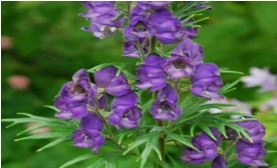Therapeutic importance of Vatsanabha (Aconitum ferox Wall.) in various diseases : A comprehensive Ayurvedic review with overview of current research
Keywords:
Vatsanabha, Aconitum ferox, Plant poison, Shodhana, AconiteAbstract
Ayurveda believes that every plant available on earth have quality to becoming a medicine. In other words, there is no plant material on the planet that cannot be used as potential therapeutic agent. There are two kinds of plants, poisonous and non-poisonous. Vatsanabha is the most poisonous plant found in Himalayas. It is used in the therapeutics of Ayurveda since time immemorial. Any substance can be incorporated into the potent medicine, only if it is used in the proper dose. But in case of poisonous plants, there are certain methods explained in Ayurveda classics, which are used to reduce or destroy the poisonous effects of it. Visha or poison is known for its quick action in the body. Keeping this principle in mind, some formulations, containing Visha drugs, are designed for fast action on the body. This article explores the literary review of Vatsanabha, purification methods, poisonous as well as therapeutic effects as described in various Materia Medica of Ayurveda. Understanding of any drug, especially clinical principles and limitations of poisonous drug plays an important role in its effective use.
Downloads
References
Ram Manohar P. Clinical Evidence in the Tradition of Avurveda: Evidence-Based Practice in Complementary and Alternative Medicine. Berlin, Germany: Springer-Verlag; 2012:70.
Yadavji T, ed. Caraka Samhita. New Delhi, India: Munshilal Manoharlal Publishers; 1992.
Dr. Shastry J.L.N., Dravyaguna Vijnana, Vol 2, Varanasi: Chukhambha Orientalia, Ed.1st, 2004, pg no 9.
Angadi Dr. Ravindra (2015). Rasa Tarangini of Sri Sadananda Sarma.1stEd. Chapter24, verse7-9.Varanasi: Chaukhamba Surbharati Prakashan.p.434.
Lucas DS. (2012). Dravyaguna Vijnana. Vol 2.Varanasi:Chaukhambha Visvabharati; p.3-8
Klásek A, Simánek V, Santavý F. Alkaloids from Aconitum plants. I. Isolation of bikhaconitine, chasmaconitine, indaconitine and pseudaconitine from Aconitum ferox. Lloydia. 1972 Mar; 35(1):55-60.
"Die dritte Defensionwegen des Schreibens der neuen Rezepte,"Septem Defensiones1538. Werke Bd. 2, Darmstadt 1965, p. 510.
Shastri Kaviraj Ambikadatta (2015). Rasaratna Samuchchaya of SriVagbhatacharya.10th Ed. Chapter 29: Visha-kalpa, verse 20-21. Varanasi: Chaukhamba Amarabharati Prakashan; pg. 643.
Shastri Kaviraj Ambikadatta (2015). Rasaratna Samuchchaya of Sri Vagbhatacharya.10th Ed. Chapter 29: Visha-kalpa, verse 43-45. Varanasi: Chaukhamba Amarabharati Prakashan; pg. 646.
Shashtri Ambikadutta (2006), Sushruta Samhita with Hindi commentary; Varanasi: Chaukhambha Sanskrit Sansthana, reprint edition, Kalpasthan 2/5 (commentary) p- 18-19.
Misra Brahmasnakar, &Vaisya Rupalalaji. (2010). Bhavaprakasa of Bhavamisra. Dhatvadivarga, Visavarga, verse-192. Varanasi: Chaukhambha Sanskrit bhawan; p. 629.
Angadi Dr. Ravindra (2015). RasaTarangini of Sri SadanandaSarma.1st Ed. Chapter24, verse 16. Varanasi:Chaukhamba Surbharati Prakashan.p. 435.
Angadi Dr. Ravindra (2015). RasaTarangini of Sri Sadananda Sarma. 1st Ed. Chapter 24, verse 10, Varanasi: Chaukhamba Surbharati Prakashan.p. 435.
Kamat S. D. (2002). Dhanvanatri Nighnatu. 1st ed. Misrakadi Varga, verse 117-118. Varanasi: Chaukhamba Sanskrit pratisthan; p.667.
Misra Brahmasnakar, &Vaisya Rupalalaji. (2010). Bhavaprakasa of Bhavamisra. Dhatvadivarga, Visavarga, verse-192. Varanasi: Chaukhambha Sanskrit bhawan; p. 629.
Sankhyadhar SC. (2012). Raj Nighantu of Pandit Narahari. 1st edition 6th Chapter, Pippalyadi Varga verse 222-223, Varanasi: Chaukhambha orienatlia; Page no.273.
Sharma PV. (1995). Priya Nighantu. 2nd Ed. Satapusphadi varga verse 194-196. Varanasi: Chaukhamba Surbharati Prakashan; p. 112.
Shastri, Pt. Kashinath and Chaturvedi Dr. Gorakh Nath (2007); Charak Samhita with Vidyotini Hindi commentary, Varanasi: Chaukhambha Bharati Academy, reprint edition, Chikitsa Sthan 1/3/24-25 pg. 38.
Shashtri Ambikadutta (2006), Sushruta Samhita with Hindi commentary; Varanasi: Chaukhambha Sanskrit Sansthana, reprint edition, Kalpasthan 2/5-6 p- 17-19.
Shastri Kaviraj Ambikadatta (2015). Rasaratna Samuchchaya of Sri Vagbhatacharya. 10th Ed. Chapter 29: Visha-kalpa, verse 18-19. Varanasi: Chaukhamba Amarabharati Prakashan; pg. 642.
Shastry Dr. J.L.N., Dravyaguna vijnana, Vol 2, Chukhambha Orientalia, Varanasi, Ed.2nd,2005, pg no 12-13.
Angadi Dr. Ravindra (2015). Rasa Tarangini of Sri SadanandaSarma. 1st Ed. Chapter 24, verse 19-25. Varanasi: Chaukhamba Surbharati Prakashan. p. 436-436.
Satpute A D. (2003). Rasendrasarasangraha of Sri Gopal Krishna. 1st Ed. 1st Chapter, Vishaupavisha, verse 365. Varanasi: Chowkhambha Krishanadas Academy, p. 255
Satpute A D. (2003). Rasendrasarasangraha of Sri Gopal Krishna. 1st Ed. 1st Chapter, Vishaupavisha, verse-366. Varanasi: Chowkhambhakrishanadas Academy; p.256.
Mishra Gulraj sharma. (1999). Ayurveda prakasha of Madhava. Chapter 6, vishaoupavishalakshanajatiguna, sevaapariharaadhyaya, verse 52-53. Varanasi: Chaukhmabaha Bharati Academy; page no. 492.
Mishra Gulraj sharma. (1999). Ayurveda prakasha of Madhava. Chapter 6, vishaoupavisha lakshanajati guna sevaaparihara adhyaya, verse 59. Varanasi; Chaukhmabaha Bharati Academy: p. 493.
Babu MSS. (2005). Yogartnakara. vol. 1. 1st Ed. ChapterVisam, verse 1. Varanasi: Chowkhamba Sanskrit series office; p. 203.
Shashtri Ambikadutta (2006), Sushruta Samhita with Hindi commentary; Varanasi: Chaukhambha Sanskrit Sansthana, reprint edition, Kalpasthan 2/12 p- 20.
Panda AK, Debnath SK. Overdose effect of aconite containing Ayurvedic Medicine ('MahashankhaVati'). Int J Ayurveda Res. 2010; 1(3):183-186. doi:10.4103/0974-7788.72493.
Rakshith N N et al, Experimental Study on Acute Oral Toxicity of Vatsanabha (Aconitum ferox wall. ex Seringe) and Antidote Effect of Sweta Chitraka (Plumbago zeylanica Linn.) Patra Swarasa W.S.R to Haematological Parameters in Vatsanabha Induced Poison, Int J Ayu Pharm Chem 2020 Vol. 13 Issue 3, [e ISSN 2350-0204].
Shastry Dr. J.L.N., Dravyaguna Vijnana,Vol. 2, Varanasi: Chukhambha Orientalia, 2nd Ed.,2005, pg 15.
Mishra Siddhi nandan. (2011). Rasendrachintamani of Dhundhuknath Acharya. Reprint edition. 7th chapter, vishaopavishasadhanaadhyaya, verse-43- 44. Varanasi: Chaukhambha Orientalia; p. 93.
Mookerji Bhudeb. (2006). Rasa jalanidhi. vol. 3, 2nd Ed. Chapter 7, Visha Adhyaya, Delhi: Parimal Publications; p. 221.















